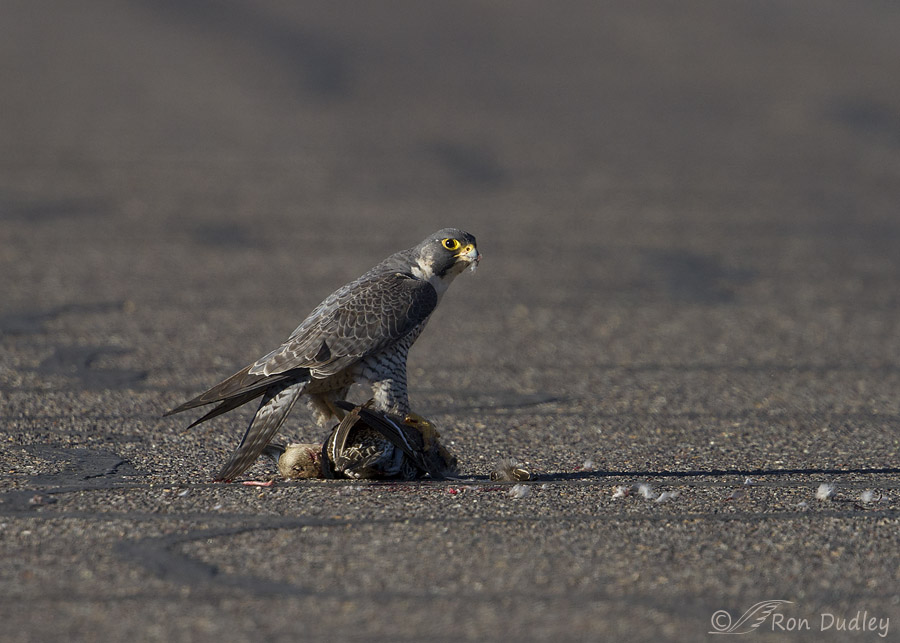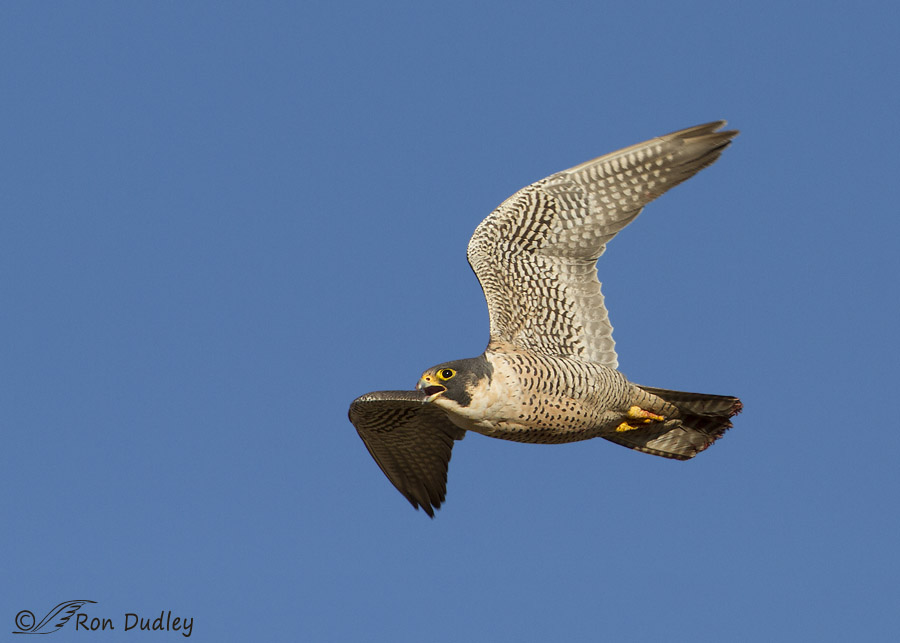I don’t often have opportunities with Peregrine Falcons in flight but this bird changed my fortunes for the better.

1/2000, f/6.3, ISO 500, Canon 7D, Canon EF500mm f/4L IS II USM +1.4 tc, not baited, set up or called in
I came across the falcon slightly less than a year ago as it was feeding on a duck in the middle of a rural road near Bicknell, Utah. (photographers may be interested in the effects of depth of field at f/6.3 on the road surface)

1/1600, f/7.1, ISO 500, Canon 7D, Canon EF500mm f/4L IS II USM +1.4 tc, canvas added for composition, not baited, set up or called in
The bird flushed and landed in some nearby trees but eventually it circled a few times which gave me some opportunities for flight shots (you can see duck debris and blood on its bill and feet). It became obvious that the bird wasn’t very happy to have been forced off its meal so I left to photograph some nearby Sandhill Cranes. For obvious reasons it always worries me when I see a raptor feeding on something on a road (this duck may or may not have been road kill) but when I returned later in the morning both duck and falcon were gone so I believe there was a happy ending.
We’re in the middle of a stormy/cloudy period and it looks like I won’t have much opportunity for bird photography in the foreseeable future so you may (or may not) see more older shots posted here than usual for a while. I already have cabin fever and it’s only been a few days.
I can only imagine how some of you folks back east must feel…
Ron


Beautiful shots Ron, they are a wonder to watch in flight. Peregrine Falcons are near to my heart, a friend got me interested in them about 5 years ago when he encouraged me to come to a fledge watch site that he has been responsible for, for many years. In urban environments the Canadian Peregrine Foundation has dozens of volunteers who keep a very close eye on the fledglings when they begin their flight lessons. Many of the young come to the ground and then become prey to other predators,traffic and sometimes bodies of water. They often select a nest ledge on a high rise building which is usually surrounded by roads or a highway. Through these efforts it was possible to bring the species back from near extinction. If a fledgling isn’t strong enough to get the altitude required to return to it’s nest ledge they end up on the ground one way or another. They are thoroughly checked over for any injuries from their ordeal and are then returned to the nest at night, so they’ll stay put for the night. It is very rewarding for the people who diligently sit hour by hour to ensure the safety of these magnificent birds. You may find there are similar practices somewhere in your area Ron.
Cori, Yes, folks do exactly the same thing around here with fledglings in trouble. We’ve had peregrines nesting on high-rise buildings in downtown Salt Lake City for years now and our young birds get in trouble just like you describe. So there’s a cadre of folks watching them from the streets below and when one gets into trouble it is rescued. However, when they crash into windows and buildings there’s often not much that can be done for them.
Wonderful Ron! Thanks so much for sharing!
Charlotte
Thanks, Charlotte.
Immediately after reading your blog i clicked on massbird to see what bird are being seen in MA and lo and behold the first entry had this link:
http://lawrenceperegrines.com
Thought a few of you might be interested in checking it out!
Again great pics Ron!
Interesting link demonstrating how well they have adapted to the urban environment in some places, Nancy. Here in Salt Lake City they’ve been nesting downtown on high buildings for quite a few years. A lot of the fledglings don’t make it though because they crash and burn when they hit buildings and windows during their early flights.
Beautiful shots of a beautiful bird. I love the pattern on the feathers in the second shot. Wish I could get to see one of these falcons in person!
Thanks, Susan. I wish you luck in seeing one. Soon!
Hi Ron,
Great shots!
I did notice that Depth of Field, thanks for pointing out the 6.3, looks great!
Bill R
Bill, I should have pointed out that that DOF was with the tc attached and from quite a distance – the image is cropped slightly more than 50%.
What a prize! Most of us don’t even get to see these birds, much less get shots like these! Incredible detail!!!
Thanks, Patty. I don’t get to see them often either so I was delighted with this encounter.
Yep, Cabin fever, I wont get disgusting about how I feel about it since today is bright, sunny, very cold, but dammit, even with snowshoes, I’m outside just the same!
Absolutely great shots of this Peregrine. This species is a testament to what man can do when he/she puts their minds to saving a species. I can remember, years ago, seeing many robins writhing on lawns dieing from DDT poisoning and also seeing what DDT can do to predator egg shells. Both the egg shells of Peregrines and Ospreys as well as others were affected by this pesticide.
Many thanks for beautiful shots of a majestic species.
Exactly, Dick. I remember the effects of DDT well (I always used to make my students learn how to pronounce the chemical name for DDT – dichlorodiphenyltrichloroethane – you can imagine how much fun I had with that!)
A hate to get political here but (kicking and screaming all the way) I’ll give Richard Nixon his due for banning DDT, whatever his motivation…
Beautiful shots Ron, as usual! I love all birds of prey…Peregrines’ are near the top. I had occasion to travel to Wy. yesterday via Weber Canyon. I didn’t see one Bald Eagle on either leg of the journey…I don’t know why, but what a poor year for eagle watching. All the best…Jer
My Bald Eagle experience this year has been similar to yours, Jerry. I have no decent shots of them this season and I’ve avoided the fishy mess out at Farmington. I’ve seen a few birds around but they’ve usually been shy and far away.
I agree, kicking and screaming as well!!
Morning from Austin, Ron! Some day I hope to see a Peregrine slicing through the air. We had some in a city I lived in (Denver) but I was never fortunate enough to see one (and know for sure it was one.) May your cabin fever be over soon.
Good morning from SLC, Arwen. I actually see them fairly often but they’re usually far out on the mud flats of the Great Salt Lake so they’re typically no larger than the focusing point on my lens. Frustrating!